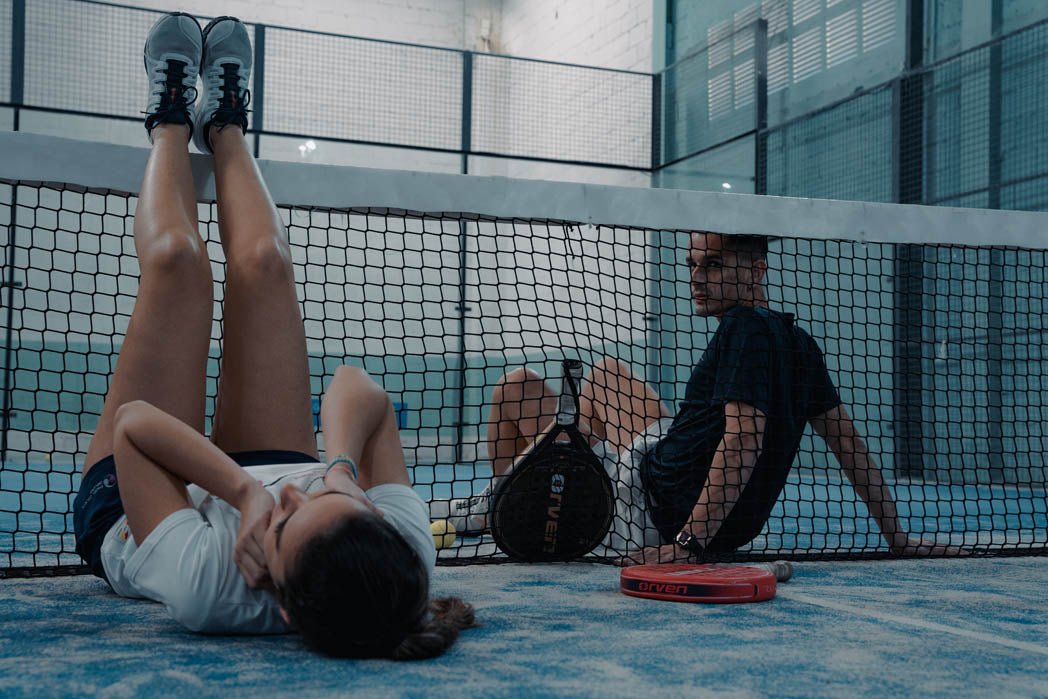Do you have doubts about the rules of paddle tennis? You will find the answers in this article. Who has not had to argue with their opponents over a point interpreted differently?
In order to play, obviously it is essential to know the main rules of paddle tennis.

Padel rules
The official rules were written by the wife of Enrique Corcuera, the man who officially invented the game in the 1970s, and stipulate that the game must always be played in pairs.
The game balls must be approved by the International Federation and are identical in all respects to those used for tennis, while the racket is about 45.5 centimeters in size, has no strings but is equipped with a series holes in the center.
According to the regulations, it must be tied with a rope or a non-elastic cord to the player's wrist.
- Number of players : although it is common to see individual courts in many facilities, paddle tennis is a team sport in which you play with a partner to compete against another couple. The individual tracks are mainly used as a training area.
- Balls : Official matches are played with 3 balls on the court, which must be new and comply with the IPF rules.
- Rackets : The shape and size of the racket must comply with the regulations. On our website you will find a wide range of quality rackets.
- Choice of court and service : at the beginning of each game you have to draw lots for the team that will start serving or the side of the court that will take. The couple that wins the draw will be able to choose between the two.
The most important rule: the serve
Let's talk about the most important padel rules. The serve is considered good if the ball bounces in the corresponding track after being hit by the serving player. As in tennis, the serve must be crossed, that is, the player who serves from the right half of the court must direct it to the left half of the opposite field.
But unlike tennis, in paddle tennis the ball is not thrown overhead to serve, but is dropped, bounced, and then hit by the player no higher than the waist at the moment of impact.
- If the ball bounces and then hits the side fence, it is considered a tie and the serve is retaken.
- If the ball bounces once and touches the side fence, it is considered an error and the player cannot repeat the serve.
- Also, if the ball bounces twice in the service box, it is considered an error and cannot be served again.
- The ball may touch the walls after bouncing once in the service box.
player position
Padel is played in pairs, the player who receives can be located anywhere on his own court, like his partner who does not receive the serve.
The partner of the server can also be located anywhere on his own court, so it is important to know the rules of padel.
Only the server must be behind the end line, to the left or right of the center line. The receiver is placed anywhere on the court, on the diagonal of the server.

The points in the paddle
Points are counted in the same way as in tennis: "15" when a pair wins one point, "30" when they win a second point in the game, "40" for winning a third point.
Depending on the different competitions, national or international, the "decisive point" rule may or may not apply.
In general, matches are played to the best of three sets (a pair must win 2 sets to win the match), except in some formats that may be different.
Service
The serve is spooned, with two attempts (first and second ball). The server first dribbles the ball (behind their own service line) and then hits it below the sideline. The server is behind the service line. The ball must bounce in the opposite service box before being hit by the receiver. If the ball does not bounce in the service box, it is a foul.
After passing the net, any ball that first touches a surface other than the ground is a foul for the server. If the ball bounces in the box and touches the net before crossing the service line (on the receiver's side), it is also a foul. If the ball hits the net and bounces into the box, it is a let. If it hits the net before the second bounce, it's a foul.
Padel rules during the match:
- Scoring : the point system is shared with tennis. The team that wins 2 sets wins the match. The matches follow the score of 15, 30, 40, advantage or tie and then it is played. Every 3 games the position of the players on the court is changed.
- Position on the court : the ball can be hit without distinction by any player and in any area of the court. It's easy to see beginners trying to talk their partner out of playing on their "side of the court."
- Game dynamics : In paddle tennis, for the ball to be considered good, it must touch the ground before it touches the walls and/or the fence. The player can hit the ball with or without a bounce, but with a maximum of one bounce on the ground. The ball can hit the ground once and bounce off the walls.
- Offside recovery : If the opponent hits the ball with force and it bounces off the court, the point is considered won by the player who made the hit. You also have the option to go off the court to hit the ball back into play.
- Recovery in the opponent's field : if, after a rebound, the ball hits one of the walls or the fence and returns to the opponent's field, the point is considered won by the player who took the shot. But, also in this case, we have the possibility of recovering the point directly in the opponent's field.
- Free kick on the net : if we touch the net with the racket, clothing or any other part of the body after hitting the ball, the point is in favor of the opponent.
How are scores calculated?
Like any sports regulation worth its salt, it is necessary to understand how scoring works in paddle tennis, which is exactly the same as in tennis. In fact, over the course of a match, divided into three sets with a 7-point tie-break in case of 6-6 in the first two games played.
Conclusion
We hope this article has served to clarify the different rules of paddle tennis. If you learn the basic rules correctly and apply our advice, you will quickly get the most out of your padel matches.





Leave a comment
This site is protected by hCaptcha and the hCaptcha Privacy Policy and Terms of Service apply.